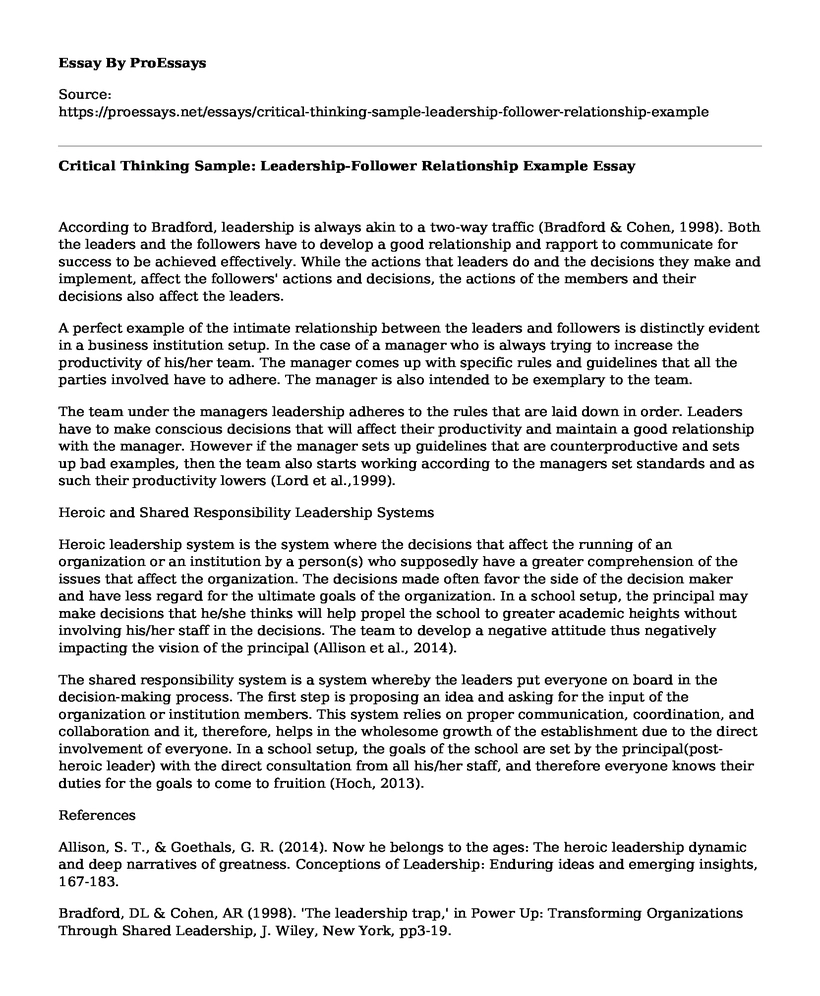According to Bradford, leadership is always akin to a two-way traffic (Bradford & Cohen, 1998). Both the leaders and the followers have to develop a good relationship and rapport to communicate for success to be achieved effectively. While the actions that leaders do and the decisions they make and implement, affect the followers' actions and decisions, the actions of the members and their decisions also affect the leaders.
A perfect example of the intimate relationship between the leaders and followers is distinctly evident in a business institution setup. In the case of a manager who is always trying to increase the productivity of his/her team. The manager comes up with specific rules and guidelines that all the parties involved have to adhere. The manager is also intended to be exemplary to the team.
The team under the managers leadership adheres to the rules that are laid down in order. Leaders have to make conscious decisions that will affect their productivity and maintain a good relationship with the manager. However if the manager sets up guidelines that are counterproductive and sets up bad examples, then the team also starts working according to the managers set standards and as such their productivity lowers (Lord et al.,1999).
Heroic and Shared Responsibility Leadership Systems
Heroic leadership system is the system where the decisions that affect the running of an organization or an institution by a person(s) who supposedly have a greater comprehension of the issues that affect the organization. The decisions made often favor the side of the decision maker and have less regard for the ultimate goals of the organization. In a school setup, the principal may make decisions that he/she thinks will help propel the school to greater academic heights without involving his/her staff in the decisions. The team to develop a negative attitude thus negatively impacting the vision of the principal (Allison et al., 2014).
The shared responsibility system is a system whereby the leaders put everyone on board in the decision-making process. The first step is proposing an idea and asking for the input of the organization or institution members. This system relies on proper communication, coordination, and collaboration and it, therefore, helps in the wholesome growth of the establishment due to the direct involvement of everyone. In a school setup, the goals of the school are set by the principal(post-heroic leader) with the direct consultation from all his/her staff, and therefore everyone knows their duties for the goals to come to fruition (Hoch, 2013).
References
Allison, S. T., & Goethals, G. R. (2014). Now he belongs to the ages: The heroic leadership dynamic and deep narratives of greatness. Conceptions of Leadership: Enduring ideas and emerging insights, 167-183.
Bradford, DL & Cohen, AR (1998). 'The leadership trap,' in Power Up: Transforming Organizations Through Shared Leadership, J. Wiley, New York, pp3-19.
Hoch, J. E. (2013). Shared leadership and innovation: The role of vertical leadership and employee integrity. Journal of Business and Psychology, 28(2), 159-174.
Lord, R. G., Brown, D. J., & Freiberg, S. J. (1999). "Understanding the dynamics of leadership": The role of follower self-concepts in the leader/follower relationship. Organizational behavior and human decision processes, 78(3), 167-203.
Cite this page
Critical Thinking Sample: Leadership-Follower Relationship Example. (2021, Apr 15). Retrieved from https://proessays.net/essays/critical-thinking-sample-leadership-follower-relationship-example
If you are the original author of this essay and no longer wish to have it published on the ProEssays website, please click below to request its removal:
- Mahatma Gadhi Leadership
- Leadership and Motivation of School Employees Essay
- The Management of Pizza Palace Mini Case Review
- Analysis of the Research on Transformational Leadership Paper Example
- Research Paper on Apple Inc Business
- Essay on Team-Leader Training: Vital for Improving Cohesiveness & Productivity
- Essay on Working Remotely: The Future of Job Market in the Digital Ag







